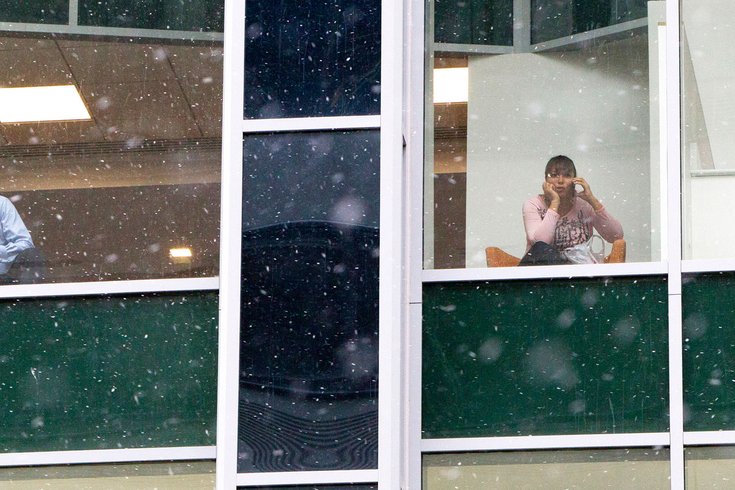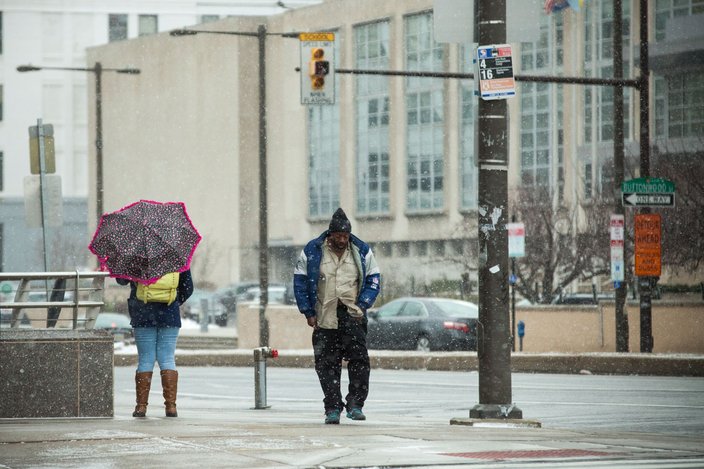
January 30, 2015
 Michael R. Sisak/AP
Michael R. Sisak/AP
People look out from office building windows as snow falls in Center City on Monday, Jan. 26, 2015. Many workers had the next day off.
As dire reports of a historic blizzard mounted Monday for the East Coast, Mayor Michael Nutter ordered cars off snow routes or risk being ticketed and SEPTA slashed its suburban rail line schedule. New Jersey Gov. Chris Christie imposed a statewide travel ban, and both he and Nutter gave non-essential public employees the day off.
The National Weather Service never predicted blizzard conditions for the Philadelphia region, but it did forecast a major storm with the potential for 18 inches of snow in the city. But the snow was pretty much a no-show. Total accumulations according to the weather service: around 1.5 inches.
And while the storm lacked punch, it delivered a solid hit to the local economy. Meteorologists apologized for the forecast, but financial consequences could be felt all the way down to the cash till.
RELATED COVERAGE: Storms like New England blizzard may get stronger but less frequent: study
The Philadelphia region alone likely lost between $50 million to $70 million in activity within the local economy - such as retail purchases and home construction - during Tuesday's bust, according to Jim Gillula, managing director of consulting at IHS Global, an economic consulting firm that has studied the issue.
Hourly employees who couldn’t easily make up the lost work time may have been among the most acutely impacted, according to two economic experts.
“Those folks can suffer some real losses,” Gillula said.
Adam Kamins, a senior economist at the financial firm Moody’s Analytics in West Chester, said Philadelphia’s response probably didn't do much to unnecessarily worsen economic activity.
“I don’t think the [city's] government itself made all that many decisions that would have changed this number materially,” said Kamins, who has been widely quoted in the media on the storm's impact.
Kamins, who said the regional estimate of up to $70 million sounded reasonable, pegged the city's loss at about $30 million. Combined, the cost to New Jersey and Philadelphia was about $200 million in lost productivity.
In 2013, the Philadelphia region saw an average of $1.1 billion in economic activity each day, according to the U.S. Department of Commerce.
Nutter spokesman Mark McDonald said it was too early for the city to know the storm’s effect on the local economy. At least residents with cars didn't have to pay for violating the city's snow emergency regulations. McDonald said no storm-related parking tickets were issued.
But others report taking a hit to the wallet.
Steve Kremp of Kremp Florist, a large flower business based in Willow Grove, Montgomery County, said weather forecasts can make a difference.
“For us, we’re servicing the public,” said Kremp. “The forecasts are terrible, they really hurt business.
“Anytime those forecasts happen, especially nowadays when media outlets make it seem like the end of the world, everything stops.”
Light snow falls at Broad and Spring Garden streets in Philadelphia on Tuesday. (Thom Carroll/PhillyVoice)
Kremp said it's not as bad when bad weather hits in January because business is a bit slower in the lead up to Valentine’s Day. If the February holiday is impacted by weather, however, there is a major impact on orders.
Last year, a day before Valentine’s Day, a storm hit and really hurt businesses. Kremp saw fewer customers buying flowers. Employees needed to deliver packages also didn’t come to work.
"If [that busted forecast had] happened two weeks from now, it would be huge," Kremp said.
For his part, Christie defended his decision to institute a travel ban on WABC-TV, after much of the state ended up with six inches of snow or less, according to weather service data.
"I was being told as late as 9 o'clock ... that we were looking at 20-inch accumulations in most of New Jersey," he told the station. "If, in fact, that is what would have happened, having these types of things in effect were absolutely the right decision to make."
Christie also decided to shutter NJ Transit on Tuesday, which carried a nearly $1.4 million loss in revenue, according to spokeswoman Jennifer Nelson. She said that number did not include monthly tickets.
SEPTA spokesman Andrew Busch said no hard numbers were available, but there was some drop in ridership because of the storm forecasts. The agency, however, did not take a major financial hit, he said.
Ridership "was less" said Busch "but nothing that was too significant or will have a major impact on our revenue." SEPTA generates about $975,000 in revenue on an average weekday, according to Busch.
When forecasters caution the public to stay indoors, restaurants and retailers see less business, according to Kamins. Other sectors, such as manufacturing, might be impacted to an extent, but some businesses have the option of making up the lost day by doing extra work at a later time.
The classic example of workers impacted by a storm are taxi drivers, Kamins said, who cannot easily work longer hours to make up for lost wages.
Natural disasters that last longer have larger economic impacts and even holidays can hinder commerce more than what occurred on Tuesday, said Kamins.
Of course, there are industries that love the snow and hype. Plow businesses benefit, and their workers may receive overtime not ordinarily available.
Staff writer John Kopp contributed to this report.
